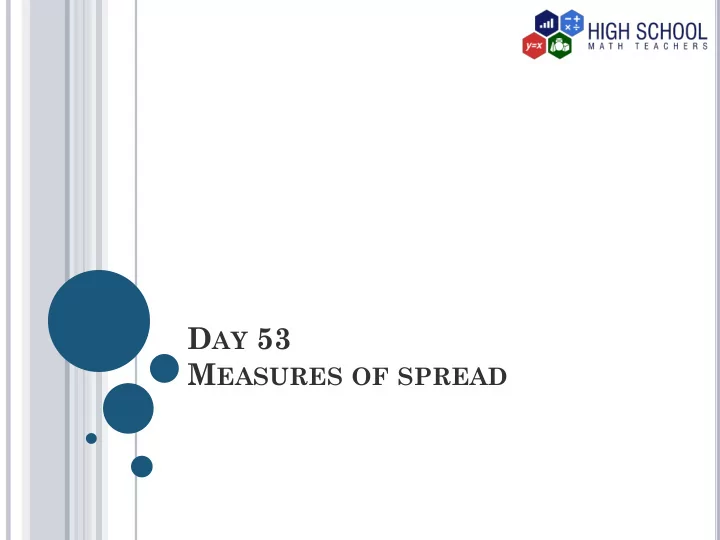

D AY 53 M EASURES OF SPREAD
I NTRODUCTION In statistics, most data sets have the different measures of central tendency. however, this is not enough to describe data; another measure that tells us how the data is dispersed worthy exploring in order to give an further description of the set. This helps us to find out how the values in the data set are scattered and how much they differ from the mean. If values in the data set are nearer to the mean, the spread is small and if the values differ from the mean by a larger extent, the spread is large.
We are going to look at different measures of spread, that is the range, interquartile range(IQR) and standard deviation.
V OCABULARY Measure of dispersion: A statistical measure that shows the similarity or variability of values in a data set. Range: The difference between the largest and smallest values in a data set. Mean Deviation: The difference between a value and the mean in the data. Quartile: A value that divides a set of data into four parts. Lower quartile , 𝐑 𝟐 : A value which lies a quarter way of the data set when the values are arranged in ascending order.
Upper quartile, 𝐑 𝟒 : A value which lies a three- quarter way of the data set when the values are arranged in ascending order.
Range It is the difference between the largest and smallest values in a data. The greater the spread of the values in a data set, the greater the range.
During a lesson, a teacher asks his students to take out their last 50 point-math-quiz for revision. He selects 7 students at random and records their marks as follows: 25, 26, 28, 32, 36, 42, 49 1. Find their mean score. Mean = 34 2. List the scores that are above the mean score. 36, 42 and 49
25, 26, 28, 32, 36, 42, 49 3. Find the range of scores. Range =24 4. Calculate the interquartile range of the scores. Interquartile range = 16 5. Calculate the standard deviation of the scores. Standard deviation = 8.264
Example 1 Six students in a class took a mathematics test and scored the following marks: 80, 76, 92, 54, 63 and 41 Find the range of their marks. Solution 𝑆𝑏𝑜𝑓 = 𝑀𝑏𝑠𝑓𝑡𝑢 𝑤𝑏𝑚𝑣𝑓 − 𝑡𝑛𝑏𝑚𝑚𝑓𝑡𝑢 𝑤𝑏𝑚𝑣𝑓 = 92 − 41 = 51
Interquartile range (IQR) It is the difference between the lower and upper quartiles in a set of data. Interquartile range = Q 3 − Q 1 Semi-interquartile range (quartile deviation) It is half of the interquartile range. Quartile deviation = Q 3 − Q 1 2
Example 2 Find the interquartile range and quartile deviation for the data set below. 14, 29, 19, 23, 20, 19, 27, 17 Solution Arranging the data in ascending order we have; 14, 17, 19, 19, 20, 23, 27, 29 The total number of values, 𝑜 = 8. 19+20 The median = = 19.5 2 There are four values below the median, therefore the lower quartile 𝑅 1 is the mean of the two middle values.
17+19 The lower quartile, 𝑅 1 = = 18 2 There are four values above the median, therefore the upper quartile, 𝑅 3 is the mean of the two middle values. 23+27 The upper quartile, 𝑅 3 = = 25 2 Interquartile range = Q 3 − Q 1 = 25 − 18 = 7 Quartile deviation = Q 3 − Q 1 = 7 2 = 3.5 2
Example 3 Calculate the interquartile range and hence calculate the semi-interquartile range for the set of data below. 112, 102, 105,103, 110, 114, 103, 107, 109, 115, 114 Solution Arranging the data in ascending order we have; 102, 103, 103, 105, 107, 109, 110, 112, 114, 114,115 The total number of values, 𝑜 = 11
The median = 109. There are five values below the median, therefore the lower quartile 𝑅 1 is the middle value, which is 103. There are five values above the median, therefore the upper quartile, 𝑅 3 is the middle value, which is 114. Interquartile range = Q 3 − Q 1 = 114 − 103 = 11 Quartile deviation = Q 3 − Q 1 = 11 2 = 5.5 2
The variance of a data set is given by the formula: 𝑦 2 𝜏 2 = Σ 𝑦 − 𝑜 where 𝑦 is the mean, n is the number of data values, and x represents each data value in the distribution. For a frequency distribution, variance is given by: 𝑦 2 Σ𝑔𝑒 2 Σ𝑔 𝑦− 𝜏 2 = or 𝜏 2 = Σ𝑔 Σ𝑔
Standard deviation Is value of the data set that shows how the value are spread from the mean. It is denoted by 𝜏 . 𝑦) 2 Σ𝑔(𝑦 − 𝜏 = Σ𝑔
Example 4 Calculate the standard of the distribution below. x 5 7 9 11 13 f 2 4 8 6 4 Solution Σ𝑔𝑦 228 We find the mean, 𝑦 = Σ𝑔 = 24 = 9.5 We set up the working as shown in the table below.
𝑦) 𝟑 𝑦) 𝟑 𝒚 𝒈 (𝑦 − 𝑦) (𝑦 − 𝑔(𝑦 − 5 2 20.25 40.5 −4.5 7 4 6.25 25 −2.5 9 8 0.25 2.0 −0.5 11 6 2.25 13.5 1.5 13 4 12.25 49 3.5 𝑦) 2 Σ𝑔 = 24 Σ𝑔(𝑦 − = 130
𝑦) 2 Σ𝑔(𝑦 − 130 𝜏 = = 24 = 5.417 = 2.327 Σ𝑔
H OMEWORK Find the standard deviation for the following data set: 10, 29,40, 52, 72, 43,14, 35, 97,40
A NSWERS TO H OMEWORK Standard deviation = 23.39
END
Recommend
More recommend